#emg pickups
Explore tagged Tumblr posts
Text
New bass project, 2024
Managed to find another History KBJ short-scale bass from a Japanese seller. Snagged it for under $200 (but the shipping cost was about the same price).

This time around I'm kitting it out as a BEAD-tuned fretted bass.
Upgrades will be:
Hipshot KickAss bridge in black (their version of the Leo Quan Badass II)
Hipshot Ultralite tuners, black
Set of short-scale BEAD strings with a .130 low B from Pitbull Strings
Swapping the stock pickups and electronics for an EMG MJ set - this is their set for upgrading Mexican Jazz Basses which often had same-length neck and bridge pickups, which is the case here. Also includes EMG vol/vol/tone controls and output jack.
Kilo International black knobs with white line pointers
#history kbj bass#short scale bass#bass upgrades#emg pickups#hipshot kickass bridge#hipshot ultralite tuners
0 notes
Text
Richard interview 2025 - about new LTD RZK-III guitar
from magazine Topguitar, published 2025-04-10, author Dariusz Domanski (found on IG lifad_ukraine)
(google translated)
Richard Z. Kruspe: "It's like a hard rock love" - about the new LTD RZK-III guitar
We talk to Richard Z. Kruspe – Rammstein guitarist and leader of the Emigrate project – about his new LTD RZK-III signature guitar, gear, Berlin and plans for 2025. You will be surprised by Richard's honesty and how much he cares about the details that affect his sound.
New LTD RZK-III
TopGuitar : Your new LTD RZK-III guitar features signature Fishman Fluence pickups. What makes them unique and what kind of tonal palette do they allow you to achieve?
Richard Z. Kruspe : I had previously used EMG pickups, but I noticed that they could sound different. Fishman gave me something I needed – repeatability and solid EQ. There is a filter under the pickups that boosts selected frequencies, giving me my signature sound, especially through my amps. That was the key.
TopGuitar : The guitar also has a special kill switch. How does it work and how do you use it?
RZK : It's the so-called "German version" of a kill switch - the opposite of the classic one. In most guitars, when you press the button, the signal is muted. In my case - there is silence until you press it. Only then does the sound appear. This arrangement allows me to play rhythmically in a different way, a bit "at once", which corresponds to the German language and way of phrasing. It's a more expressive rhythm
TopGuitar : The guitar also has a tune-o-matic bridge and stop tail that are set into the body. Why this choice?
RZK : I have always been a fan of Floyd Rose bridges – not because of the tremolo, but because of the attack and comfort of playing. We tested three versions for this guitar: with Floyd, with a classic stop tail and with a through string attachment. The stop tail won because of the sound. But to maintain the comfort of playing, we had to recess it into the body. Thanks to this, we achieved the perfect balance between sound and comfort. My friend, the German luthier Alex, helped me with this – we searched for the perfect depth for a long time.
TopGuitar : The guitar also has a tune-o-matic bridge and stop tail that are set into the body. Why this choice?
RZK : I have always been a fan of Floyd Rose bridges – not because of the tremolo, but because of the attack and comfort of playing. We tested three versions for this guitar: with Floyd, with a classic stop tail and with a through string attachment. The stop tail won because of the sound. But to maintain the comfort of playing, we had to recess it into the body. Thanks to this, we achieved the perfect balance between sound and comfort. My friend, the German luthier Alex, helped me with this – we searched for the perfect depth for a long time.
TopGuitar : The LTD RZK-III is significantly cheaper than the ESP Custom. What would you highlight for those considering buying this guitar?
RZK : I've never had an LTD before. The ESP Custom is a great guitar, but it's very expensive - around $12,500. The LTD costs around $2,000 and I'm really proud of it. Of course, we had to give up a few things, like the Sustainiac, which I use mostly in the studio anyway. The most important thing is that the guitar sounds great and is very comfortable to play - and that was key for me.
TopGuitar : Is the dual signature Fishman Fluence pickup set versatile enough, or is it designed for your sound?
RZK : Everyone plays differently, so that's a tough question. But for me, this guitar is like a good, hard strum - perfect for heavy riffs, just a "rock beast". Sure, you can play blues or jazz on it, but for me it's more of a brutal, physical relationship. Like a rough romance - laughs.
TopGuitar : On the LTD version, your RZK logo is on the back, not on the front like on the ESP. Why?
RZK : I wanted this guitar to “stand for itself.” Not everyone likes signature instruments, so hiding the graphic on the back lets people play it without feeling like they have to be me. It’s still my guitar, just more visually neutral.
TopGuitar : The ESP version has Sustainiac, the LTD does not. Does the lack of this effect bother you?
RZK : No. I mainly use Sustainiac in the studio. I play without it on the Rammstein shows. It's more of a "gadget" that wasn't necessary in this version, especially since we wanted to keep the price affordable.
TopGuitar : You have been with ESP for over 20 years. What do you value most about these guitars?
RZK : Consistency. I always know what to expect.
Music, Emigrate and Rammstein
TopGuitar : In Emigrate you have complete artistic freedom. Are there things you do there that wouldn't make it in Rammstein?
RZK : At first it was like that. But over time I realized that by limiting myself I was closing myself off to surprises. Sometimes the idea for Emigrate appealed to Rammstein members – and vice versa. Now I just write music where it's needed. I don't want to self-censor.
TopGuitar : Does Berlin still inspire or has it become more commercial?
RZK : There is a lot of commercialization, especially in electronica. Rock was never a dominant trend in Berlin. There was a punk scene, there was Bowie, Nick Cave, but after the fall of the wall everything went towards electronica and DJs. Since the pandemic, this has also changed – the party atmosphere is not the same anymore. But I myself am no longer a "party animal".
TopGuitar : Do you use different equipment in Emigrate than in Rammstein?
RZK : Not really. Guitars and amps are similar. The bigger differences are in the sound of drums and vocals – they give character.
TopGuitar : Are you planning any Emigrate concerts or is it still a studio project?
RZK : I don't have any plans. But... never say never. I stopped making plans - I noticed that cool things happen when you don't plan them.
TopGuitar : And what are Rammstein and Emigrate's plans for 2025? Can you reveal anything?
RZK : No plans. Seriously. The old saying goes, "Want to make God laugh? Tell him your plans." - and there's some truth to that.
TopGuitar : Thank you, Richard. We wish you good luck and look forward to hearing more of your music – especially here in Poland.
RZK : Thank you very much. See you soon!
#rammstein#richard kruspe#rammstein interviews 2025#good to hear he's guitar geeking#🥰#love that emigrate is not as distant from rammstein anymore#some emigrate ideas appealed to rammstein members#aawww💞💞#they really have come a long way#little bit sign of life
42 notes
·
View notes
Text
btw for anyone wanting to do a modern band!au with Mydeimos as a guitarist, in keeping with his metal theme, you'll wanna give him an electric guitar with two humbuckers! The classic Gibson Les Paul achieves this and is used by many musicians even if it may not 'look' like a metal guitar, so you'll wanna use one with similar specs. There's probably Flying Vs with 2 humbuckers but they're not very comfortable to play unless you're standing w/ a guitar strap, fyi!
And if you wanna get extra fancy, give him a guitar with EMG pickups. They're like battery-powered humbuckers that have sound muting so they're clearer/less scratchy than traditional humbuckers. Or give him a 7-string for that crunchy Korn sound!
21 notes
·
View notes
Text
Ok, I'm bored
10 GUITARS GWEN WOULD DO UNSPEAKABLE THINGS TO OWN
Gibson DG-335 (Original Run)
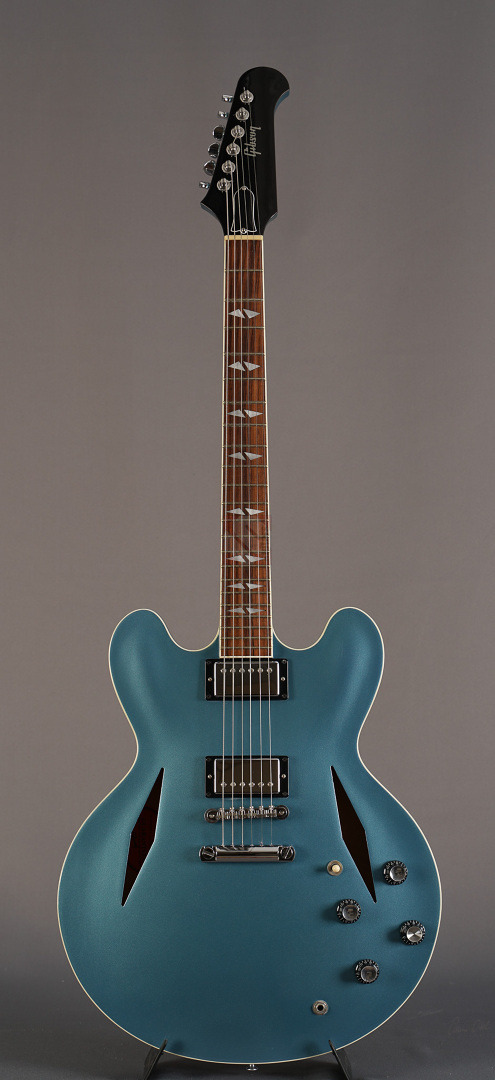
I'm not secretive about this, but one of my major inspirations is Dave Grohl of the Foo Fighters. This, based on the Trini Lopez 335 with modifications, is one of his weapons of choice. No hate to the Epiphone DG-335 (In fact I'd actually like to have one of those since it's a model I can actually fucking afford) but this would be the prize jewel of my collection
Gibson Explorer (With caveats)

While I love this thing, I do want some features not available on standard Explorers. Mainly, a volute (Added material at the midpoint of the neck and Headstock), a set of Burstbucker pickups (or similar PAF pickups), and in Shell Pink.
Fender Nocaster (Either Vintera II or original)

A Tele without a name, which happened because of a copyright Grestch held on the original name, the Broadcaster. I also just like Telecasters, and TBH, these are just cool bits of history.
Fender Kurt Cobain Jaguar
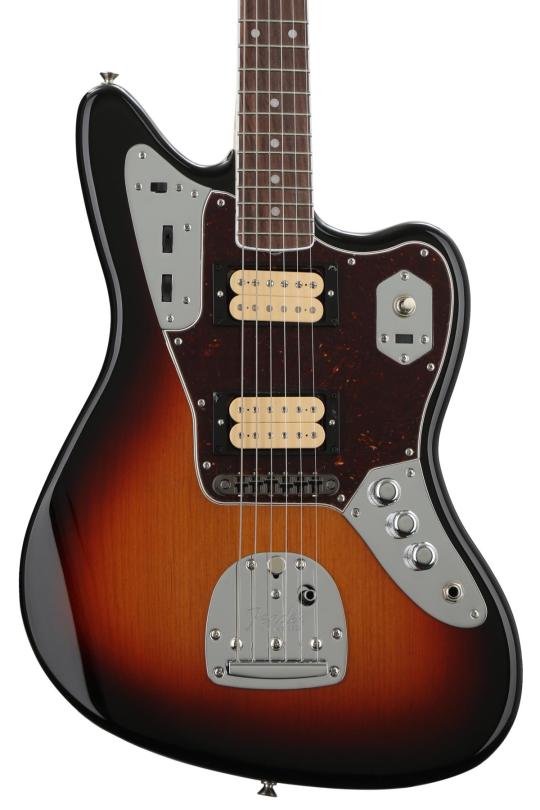
Nirvana is a band I have found a love for. Kurt Cobain was a genius on the guitar, and I find he and Grohl influence a lot of my style on guitar. This is one of his many modified guitars, and I personally really want it, especially for the upgrades like the Tune-O-Matic bridge and separate volumes for the pickups.
ESP E-II Eclipse

While I by no means am a metalhead, I do really enjoy "Metal" guitars. Stuff like the Explorer, ESPs lineup, even something like the 5150 amp. This is a beautiful thing, a pastiche of the ebony Les Paul Custom with modern features like EMG pickups, a volute, and a thinner body.
Epiphone Les Paul Custom (Birth Year)

Speaking of, this beautiful thing. As much as I love a guitar that makes my wallet scream in terror, I like the simple stuff too. I love the Les Paul shape, and the man behind the guitar was invaluable. Seeing this guitar up on a wall with the name "Les Paul" under it is an inspiration.
EVH SA-126

I actually saw this guitar before it was released. Wolfgang Van Halen, son of the incredible Eddie Van Halen, was at Rockville 2024 with a road testing prototype. Playing one of these in a Guitar Center was unreal, because it felt so light and growled through the amp. Plus, look at it. It's beautiful.
Martin D-18e (Replica)
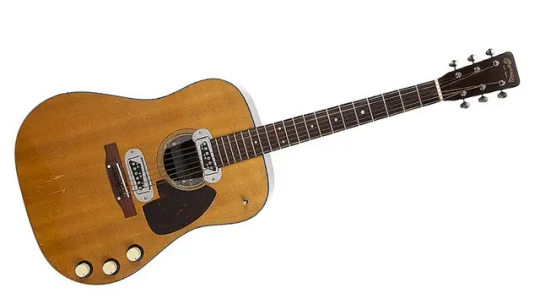
A odd choice, certainly. I mean, these are mega expensive and rare, and the one pictured here is the awe-inspiring model played by Kurt Cobain in Nirvana's MTV Unplugged concert. But, there's the rub. I don't want an original. As a challenge, I want to recreate this with a cheaper Dreadnought acoustic, the exact pickup model (which are still sold), and any custom modifications needed to replicate that historic model, much like Nirvana Guitars did (minus the modifications Kurt Cobain and his guitar tech made such as the soundhole pickup.)
Schecter Ultra (Pelham Blue)

Again, I like metal guitar gear. Schecter Guitar Research is one of those companies I've heard good things about, but as someone who doesn't really vibe with S-style guitars, I don't really look too much for their stuff. This is different. It adds elements of the Gibson Firebird, Telecaster, all with modern features and a beautiful look.
Gibson/Epiphone SG Special (Pelham Blue)

I just really like the SG body shape. It's fucking devil horns. With all my talk of how much I love this, is it a surprise it's on here? Although, honestly, I showed the Gibson version because the Epiphone version is relatively cheap, especially in comparison to their recent output (Fuck you, Epiphone Ripper being $1000+), so the Gibson version would probably be a bit more out of reach.
#gwen rambles about guitars#gwen's random thoughts#guitars#guitar#fender#gibson guitars#esp guitars#schecter guitar research
6 notes
·
View notes
Text
For #MusicMonday:



“SPIDER 13” Electric Guitar KH-3 ESP Custom Shop, Tokyo and Los Angeles c. 1992 Alder body, maple neck, rosewood fingerboard; 24¾ in. scale; black finish, decals; active EMG 60 and 81 humbucking pickups, three-way selector switch, two volume controls and one tone control Collection of Metallica and Frantic Inc.
From the Met’s 2019 “Play It Loud: Instruments of Rock & Roll” exhibition
The name of this instrument derives from the decals of a spider and the number 13 on its body, which were designed by hardcore punk, metal, and skate artist Brian "Pushead" Schroeder. Kirk Hammett first used the instrument on tour in 1992 in support of Metallica's 1991 self-titled album, commonly known as "the Black Album," and has continued to use it for live performances since.
#animals in art#museum visit#20th century art#guitar#electric guitar#instrument#musical instruments#rock and roll#heavy metal#Metallica#spider#exhibition#Music Monday
20 notes
·
View notes
Text
METALLICA - EMG pickups celebrate 40 years of "Ride The Lightning" with new James Hetfield pickups #metallica #jameshetfield #guitars #emg #emgpickups #ridethelightning
METALLICA – EMG pickups celebrate 40 years of “Ride The Lightning” with new James Hetfield pickups #metallica #jameshetfield #guitars #emg #emgpickups #ridethelightning JH “HET” SET SPECIAL EDITION AVAILABLE STARTING, November 29th, at 9am PT Limited Edition Het Set: Honoring 40 Years of Ride the Lightning To celebrate the 40th anniversary of Metallica’s legendary Ride the Lightning, EMG and…
0 notes
Text
DIY ProCo RAT: The True Vintage Distortion Pedal

Hello, and welcome to my guitar effects workshop! This circuit has existed for 46 years and is not that popular today. But if you want tons of vintage mojo, you should consider buying or making a ProCo RAT yourself.
This is one of the world's first full-fledged distortion pedals. Do you know why they stand out among other overload effects?
Fuzz is a highly high-gain pedal; it distorts the signal significantly and gives it a very specific sound, completely different from tube amplifier overdrive. However, fuzz is not technically an amplifier. The fuzz needs an amplifier with a cabinet to create the timbre of the sound. Adding fuzz to the line input will be a mistake; the sound will be terrible.
Overdrive, on the other hand, is a moderate gain pedal. Combined with the clean channel of a Fender-like amp, it gives the sound-breaking blues vibe. If connected to the input of an already overdriven amp like Marshall or Orange, the overdrive pedal not only pumps up the gain but also focuses the sound, emphasizing certain frequency bands and suppressing others.
Overdrives have built-in signal limiters on diodes, LEDs, or MOSFETs. Still, setting the gain so high that the limit triggers is unnecessary. It is assumed that we're clipping an overdriven amp plus the internal clipping of the overdrive pedal.
Boosters should also be mentioned; when the headroom is large, they do not limit the signal but simply increase its amplitude. Today, they are often built into electric guitars, especially bass guitars.
Some pickups, like the EMG and Fishman Fluence, have built-in boosts. And for electro-acoustic guitars with piezoelectric pickups, a built-in preamplifier is a must, taking into consideration the high output impedance and weak signal of the piezo pickup.
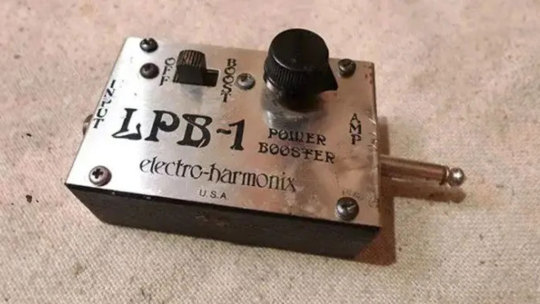
Transparent boosters have an amplitude-frequency response close to linear, like the 1968 Electro-Harmonix LPB-1 Linear Power Booster does.
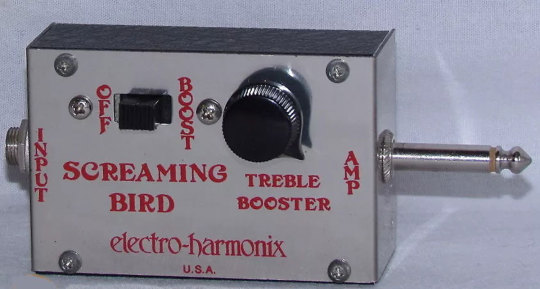
A variation called Screaming Bird was released in 1970, and it was a treble booster, a much-needed item for many vintage tube amps.

Thanks to the Screaming Bird, the clean sound became crisper, individual notes were clearer, and the presence of the guitar in the mix was more obvious. The amplifier did not choke on the bass when overloaded, so the result was not fuzz but overdrive or distortion.

Here is the 1965 diagram of the British Dallas Rangemaster Treble Booster. I won't claim that Mike Matthews copied it when developing the EHX LPB-1; it's just a transistor stage with a common emitter. Such stages are found in many pedals, radios, and so on. But I won’t rule out this possibility either; we learn from each other.

Guitar amplifiers were also produced under the Dallas Rangemaster brand.
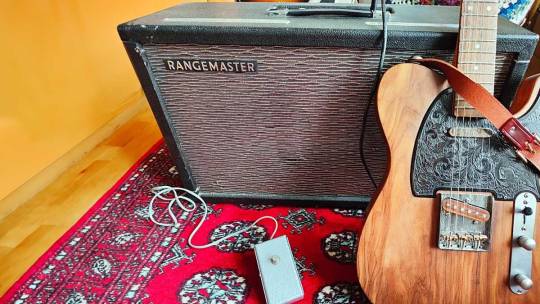
Besides the Linear Power Booster and Screaming Bird Treble Booster, as you might have guessed from the diagram, EHX released the Mole Bass Booster.

The pedal-style version of the bass booster was called Hog's Foot.
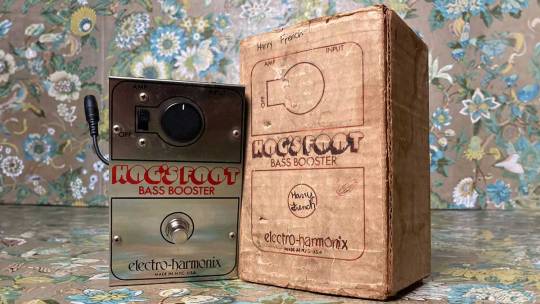
Finally, some buffers do not only change the frequency spectrum of the signal but also its amplitude. Simply put, they have high input and low output impedance, thus helping to mitigate signal losses in the effects chain. The loss of high frequencies due to the influence of cable capacitance is the primary candidate for such an application.
The amplification devices between the electric guitar and the amplifier input can differ. Then what is distortion?
A full-fledged distortion is already a preamplifier, equipped with clipping and timbre shaping. Theoretically, it can be connected to the input of a power amplifier with a guitar cabinet for a fair level of sound quality.
Not every distortion pedal is an amp in a box. And most amps in a box sound even better when connected to the input of a tube amp rather than a power amp. However, each distortion pedal has its own character and recognizable sound.
So here we have the 1978 ProCo RAT circuit diagram. If you're familiar with guitar pedal circuitry, you know that most distortion circuits look similar or have similar building blocks. Because it was ProCo RAT that laid these circuitry foundations.
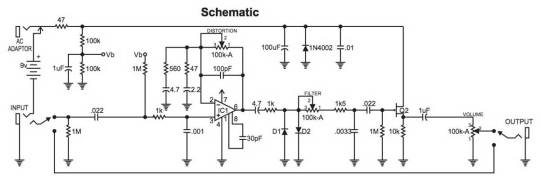
Many filters will catch your eye if you know what to look for in the diagram. First, an input filter consists of a 22 nF series capacitor, a 1 kΩ resistor, and a grounded 1 nF capacitor.
The 30 pF capacitor is a standard component to compensate for the frequency characteristics of the good ol' LM308 op-amp.
It is believed that only the LM308 can provide authentic RAT sound. That's true; the circuit is very dependent on the specific characteristics of the op-amp, namely frequency response and slew rate.

Since 2005, ProCo RAT pedals have been using OP07 operational amplifiers, almost a complete analog of the LM308. With the LM741, the circuit also works and sounds fine, but nothing like the original one.
A 100 pF capacitor between the output and the inverting input is found in many pedal circuits. It prevents the op-amp from self-oscillating and generating unpleasant high-frequency sound components called "sand."

There are as many as two RC circuits between the op amp's non-inverting input and ground: 4.7 uF 560 ohms and 2.2 uF 47 ohms. From previous articles on guitar pedals, we already know that such a filter stage determines the frequency structure of the overdrive.
Pedals like the Hermida Zendrive and Horizon Devices Precision Drive feature a reconfigurable filter. And ProCo RAT has two of those. This is one of the secrets to the pedal's famous sound character.
Next, a limiter on two back-to-back diodes is included, followed by another filter acting as a tone regulator.
Finally, the pedal's output includes a JFET buffer and volume control.
The Landtone kit I've assembled has an original vintage LM308 with signs of re-soldering. RAT distortion sounds the way it should with this chip.
youtube
0 notes
Text
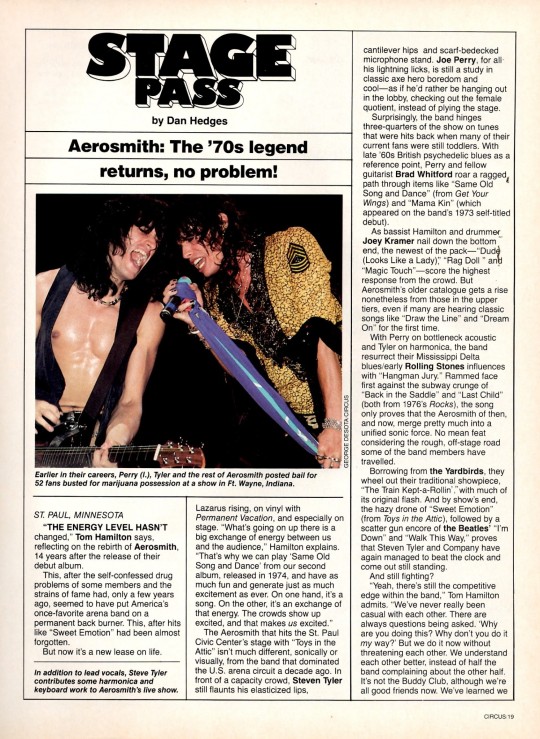

#circus#circus magazine#aerosmith#joe perry#steven tyler#ad#EMG#emg pickups#G.A.S.#guitar audio system#epiphone
1 note
·
View note
Link
Featuring a hot pink and purple finish, this high-performance guitar boasts EMG pickups, a Gotoh tremolo, and premium hardware.
0 notes
Text
Customizing Your Epiphone Electric Guitar: Tips and Tricks

Customizing your Epiphone electric guitar is a great way to enhance its performance, tailor its sound to your preferences, and make it truly your own. Whether you're a seasoned player or a beginner looking to experiment, there are numerous modifications you can make to improve your instrument. This article will provide tips and tricks for customizing your Epiphone electric guitar, focusing on changes that can make a significant impact without breaking the bank.
1. Upgrading Pickups
One of the most impactful modifications you can make to your Epiphone electric guitar is upgrading the pickups. Pickups are the heart of your guitar's sound, and swapping them out can drastically change your tone.
Humbuckers vs. Single-Coils: Determine whether you prefer the warm, full sound of humbuckers or the bright, crisp tone of single-coil pickups. Epiphone guitars, such as the Les Paul and SG models, typically come with humbuckers, which are great for rock and metal. If you're looking for a cleaner, more articulate sound, consider installing high-quality single-coil pickups.
Popular Choices: Brands like Seymour Duncan, DiMarzio, and EMG offer a variety of pickups that can suit different musical styles. Research and listen to demos to find the best match for your desired sound.
2. Upgrading Hardware
Upgrading your guitar's hardware can improve its tuning stability, sustain, and overall playability.
Tuning Machines: Swapping out stock tuning machines for higher-quality locking tuners can greatly enhance tuning stability. Brands like Grover and Schaller are popular choices that offer reliable performance.
Bridge and Tailpiece: Upgrading to a better bridge and tailpiece can improve sustain and intonation. Consider options like the Tune-o-Matic bridge, which is standard on many Epiphones, but look for higher-quality versions from manufacturers like Gotoh or TonePros.
Nut: Replacing the stock nut with a bone, graphite, or TUSQ nut can improve tuning stability and sustain. A well-cut nut also ensures that your guitar stays in tune better, especially when using the tremolo or bending strings.
3. Electronics Upgrade
Improving the electronics in your Epiphone can refine your tone and give you more control over your sound.
Pots and Capacitors: Upgrading the potentiometers (pots) and capacitors can provide smoother volume and tone control. High-quality pots from brands like CTS and capacitors from Orange Drop can make a noticeable difference.
Switches and Jacks: Installing a high-quality toggle switch and output jack can increase reliability. Switchcraft is a well-regarded brand for these components.
Wiring: Consider upgrading to a vintage-style wiring harness, which can improve your guitar’s tonal response. It’s also an opportunity to ensure all connections are solid and eliminate any potential noise issues.
4. Cosmetic Customizations
Customizing the look of your guitar can be just as satisfying as improving its sound and playability.
Pickguards and Control Knobs: Swapping out the pickguard and control knobs can give your guitar a fresh look. Epiphone guitars often come with standard colors and designs, so adding a custom pickguard or vintage-style knobs can make your instrument stand out.
Finish and Decals: If you're feeling adventurous, you can refinish your guitar or add decals and stickers for a personal touch. Be careful with refinishing, as it can be a complex process that might affect your guitar’s value if not done correctly.
Truss Rod Cover: A custom truss rod cover is a simple way to add a unique touch to your guitar. Many online retailers offer personalized covers with engravings or custom designs.
5. Setups and Maintenance
Finally, regular maintenance and a professional setup can make a world of difference in how your guitar plays and feels.
Action and Intonation: A proper setup involves adjusting the action (string height) and intonation (string length) to ensure your guitar plays in tune across the entire neck and feels comfortable under your fingers.
Neck Relief: Adjusting the truss rod to set the correct amount of neck relief is crucial for playability. Too much or too little relief can cause buzzing or make the guitar difficult to play.
Fretwork: Over time, frets can wear down, causing buzzing and intonation issues. A fret level and crown, or even a complete refret, can restore your guitar to optimal playing condition.
Conclusion
Customizing your Epiphone electric guitar can enhance its performance, personalize its sound, and make it uniquely yours. From upgrading pickups and hardware to making cosmetic changes, there are numerous ways to improve your instrument. Regular maintenance and professional setups are also key to ensuring your guitar plays and sounds its best. With these tips and tricks, you can take your Epiphone to the next level and enjoy a truly personalized playing experience.
0 notes
Text
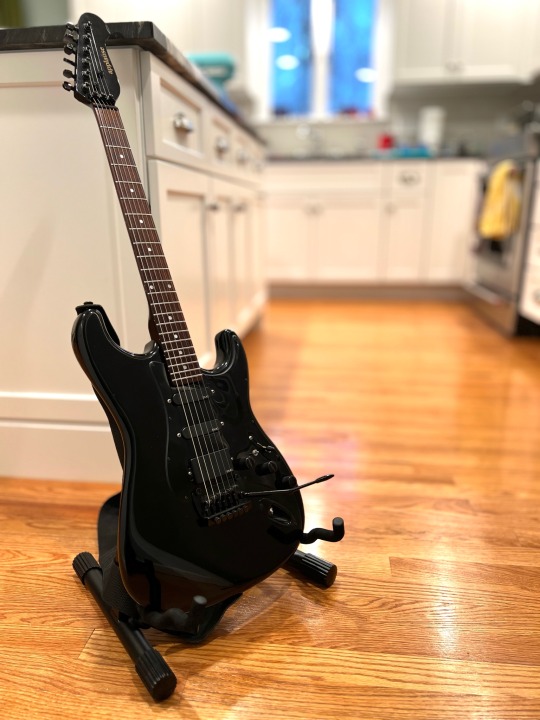
Today I got my Applause AR19T back from the shop. This Fender Stratocaster copy, made by Ovation and manufactured in Korea, was the first guitar I ever purchased, back in 1989, for $280 ($710 in today's cash). With its Floyd Rose style bridge and HSS pickup configuration, it's quite a formidable instrument, especially since I souped it up a bit more by adding EMG S/S/81 pickups back in 1992.
Every time I play it, I'm amazed at how good it sounds. When paired with some fuzz it definitely produces that unique sound that's all over albums like Siamese Dream by Smashing Pumpkins. It's solid proof you don't need an instrument with a well known name on the headstock to produce quality music.
1 note
·
View note
Text
Bootlegger Guitar Absinthe ~ EMG Pickups: Unleash Your Sonic Journey
Are you looking for an exceptional headless guitar that combines innovation with quality craftsmanship? Look no further than the Bootlegger Guitar Absinthe, featuring Gen 2 Absinthe Fixed Bridge or Tremolo EMG Pickups with Coil Split options. Crafted in collaboration with EMG, this model boasts a redesigned neck for enhanced stability and tone. Embark on a sonic adventure with the Absinthe headless guitar.
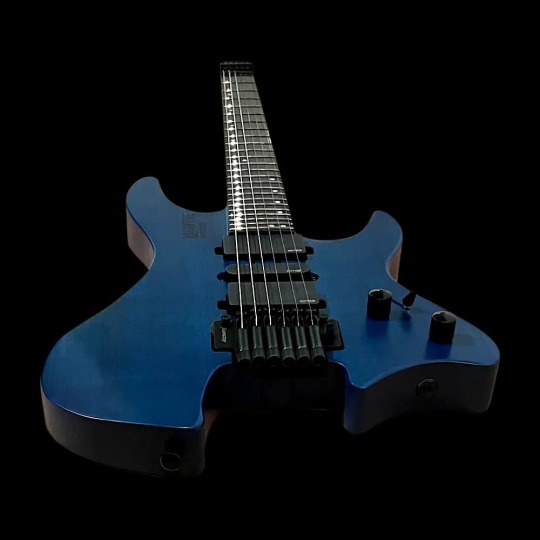
0 notes
Text
Ugh. I like Floyd Roses now.
So, backstory. I went to a Guitar Center. This one wasn't the one I normally go to, but I was in the area and tried out some gear. For me, a Guitar Center, or any instrument shop for that matter, is a toy shop. Go in, look and play with what's on the floor, and have fun. It's a treasure trove for a gear nerd like me. I've tried many different pickups, different body styles, and more at places like Guitar Center. So, I see a guitar I've heard some stuff about, and seen a demo of.

The Schecter Sun Valley Super Shredder FR S.
Let's break this down.
To start, a Floyd Rose is a type of guitar tremolo system. It tightens and loosens the strings, creating a swell in pitch. Most trem systems are limited, only being able to go so much up and down before bottoming out and occasionally detuning your string. This is not the case with a Floyd Rose. The Floyd Rose is a locking tremolo, meaning your strings are locked into their tuning at the nut. Technically you can change it, but that involves fumbling with the violin tuners at the bottom and/or unscrewing the nut. Downside? These things are a bitch and a half to service, especially string changes. Upside? You can do whatever you want to the bar on your trem, it'll stay in tune when it returns to pitch. These are fun as hell to play, honestly. You can go super low and high, but this guitar wasn't like any others with a Floyd Rose. Let's get a closer look at the pickups.
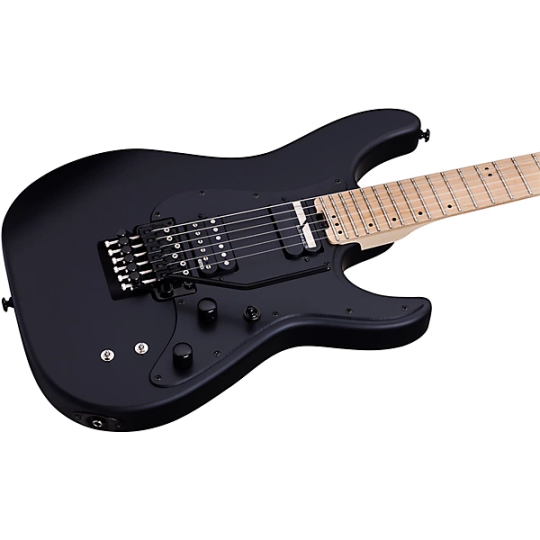
One of those is not normal. The bridge is your traditional EMG (uncovered too) but the neck? That's the magic. That's what's known as a Sustaniac. As far as I understand it, it's a pickup that can reverse itself. When it's turned "off" it's a normal active pickup. When it's turned "on" however, it takes the vibrations of the strings and sends it back, making it essentially ring out forever. With this system, you could fret a note, and as long as you keep the finger on the note, it'll keep playing. There are also 3 modes to it. There's normal sustain, what I just described, Dissonant, which can simulate amp feedback and make a loud squeal (which is super fun), and Harmonic, which is exactly what it sounds like, a much more harmonic sustain. Of course, talk is cheap, so I recommend this video by SamuraiGuitarist which goes into more depth.
Essentially, with these combined, you can get some strange sounds, especially paired with a distorted amp. I really want one of these (or the similar Telecaster version) to play with, either in an actual song or just to fuck around with.
1 note
·
View note
Text
Megadeth Holy Wars
Megadeth Holy Wars The tone for the song: “Holy Wars” by Megadeth. Featuring 3 custom patches. I’ve used a Jackson Guitar with EMG Pickups. All tones were recorded straight into an UAD Apollo Interface. No post FX were added. Ideal for live PA, Studio Monitors and you can also you it on your Amp’s Return FX Loop Included is the backing track that I’ve used for the…

View On WordPress
0 notes
Text
btw does anyone know if EMG 7H pickups will fit in a PRS SVN SE? the measurements match but i dont know if the cavities are deep enough
in my desparate search for information, i have posted on Reddit for the second time in my life...
1 note
·
View note